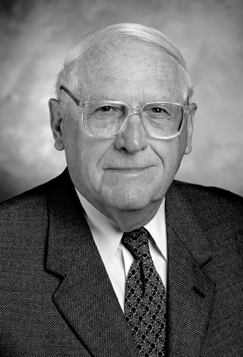 Larry
Funkhouser meets once a year with about 25 other oil exploration geologists
who worked with him during his long career at Chevron. At their gatherings,
he says, they “tell all the old war stories, about the good ones and the
bad ones.” From the discovery of new and successful oil and gas fields
in Australia, Wyoming and the North Sea, as well as offshore Spain and Newfoundland,
to prospecting in Sudan and the loss of several co-workers during the civil
war there, Funkhouser spearheaded Chevron’s search for oil around the world
as vice president of exploration and production. His career has followed the
oil industry from postwar boom through later highs and lows. In April, he received
his colleagues’ highest recognition, the 2004 Sidney Powers Medal, at the
meeting of the American Association of Petroleum Geologists (AAPG) in Dallas.
Larry
Funkhouser meets once a year with about 25 other oil exploration geologists
who worked with him during his long career at Chevron. At their gatherings,
he says, they “tell all the old war stories, about the good ones and the
bad ones.” From the discovery of new and successful oil and gas fields
in Australia, Wyoming and the North Sea, as well as offshore Spain and Newfoundland,
to prospecting in Sudan and the loss of several co-workers during the civil
war there, Funkhouser spearheaded Chevron’s search for oil around the world
as vice president of exploration and production. His career has followed the
oil industry from postwar boom through later highs and lows. In April, he received
his colleagues’ highest recognition, the 2004 Sidney Powers Medal, at the
meeting of the American Association of Petroleum Geologists (AAPG) in Dallas.Larry Funkhouser received the 2004 Sidney Powers Medal at this year’s American Association of Petroleum Geologists meeting in Dallas. Courtesy of AAPG.
Funkhouser has always been a commanding presence in the field, according to Jack Threet, who was a former competitor when he worked at Shell and later became one of Funkhouser’s business partners in an independent oil exploration company. “He is considered within Chevron to be a mentor of many geologists and explorers,” Threet says. “In later years I was able to see firsthand exactly why that would be. He’s an astute fellow with an interest in geology and an interest in people — to see that they got recognized for what they were good at.”
William Crain, who became Chevron’s vice president of exploration and production in 1988, calls him “personable” and “positive” and notes Funkhouser’s excellent memory. “He could remember details about people, their education, what their brothers and sisters did,” information he would sometimes then use to help fit people to the best work positions, Crain says. In one instance, he suggested asking a Houston-based geologist to teach seismic interpretation to Chevron employees in Nigeria, knowing that the geologist’s sibling had served in a U.S. embassy in Africa; the geologist jumped at the chance. Threet calls that personal interest part of Funkhouser’s “Midwest sincerity.”
As a boy in Napoleon, Ohio, Funkhouser learned to love geology from his older brother Harold, who “would come home with fossils and rocks and books and maps” from his own coursework in geology at Miami University of Ohio. Harold, who was six years older, went on to become vice president of oil exploration for Gulf Oil. Funkhouser decided he too would be a geologist, and he attended Oberlin College, earning an A.B. in geology (Oberlin later gave him an honorary doctorate). He served in Africa during World War II and when he returned home, married his college sweetheart, Jean Cooper.
Funkhouser earned his master’s degree at Stanford in 1948, studying under A.I. Levorsen. After receiving his degree, he began his career at Standard Oil (Socal). He and Jean (and soon their first child of four) traveled together throughout the United States for several years. In New Orleans, “he first caught the eye of corporate officers of Socal,” Threet said in his citation at the AAPG award ceremony. “He was directing an ever-larger number of geologists and geophysicists in a manner which demonstrated that he knew and practiced the importance of motivating people.” When he was tapped for a higher position in the corporation, Funkhouser and his family moved to San Francisco; in 1969, he became vice president of exploration and production for Socal, which officially became Chevron in 1977.
Funkhouser says without hesitation that his years at Chevron were the best in the industry, before the mid-1980s oil price shock. Until then, he says, petroleum geology held exciting new opportunities, new technologies and company cultures that were like family. At Chevron, which had around 1,100 exploration people, from geophysicists to paleontologists, he says, “we worked together and were best friends together.”
Crain also says that the company reflected Funkhouser’s leadership and his ethical behavior — something other companies recognized and that affected Chevron’s business dealings. Funkhouser, he says, expected that the company would seek out “big plays,” and he trained people to “look big.” He also “had the knowledge to pull out when something that looked big turned out not to be,” Crain says.
After his retirement from Chevron in 1986, Funkhouser remained an integral actor in the petroleum geology community. After decades as competitors, he and Threet (also retired) formed an independent oil exploration company with three other business partners, allowing Funkhouser to return to his geologic roots. He also served as president of AAPG and later as president of the AAPG Foundation. Threet noted that during Funkhouser’s tenure, the foundation doubled its financial holdings, while supporting numerous geology education programs and other concerns.
Although he may be a competitive and tough businessman who guided one of the giants of the industry, Threet says, Funkhouser still retains his personable Midwestern character — and his love for oil exploration geology.
Naomi Lubick
Back to top

